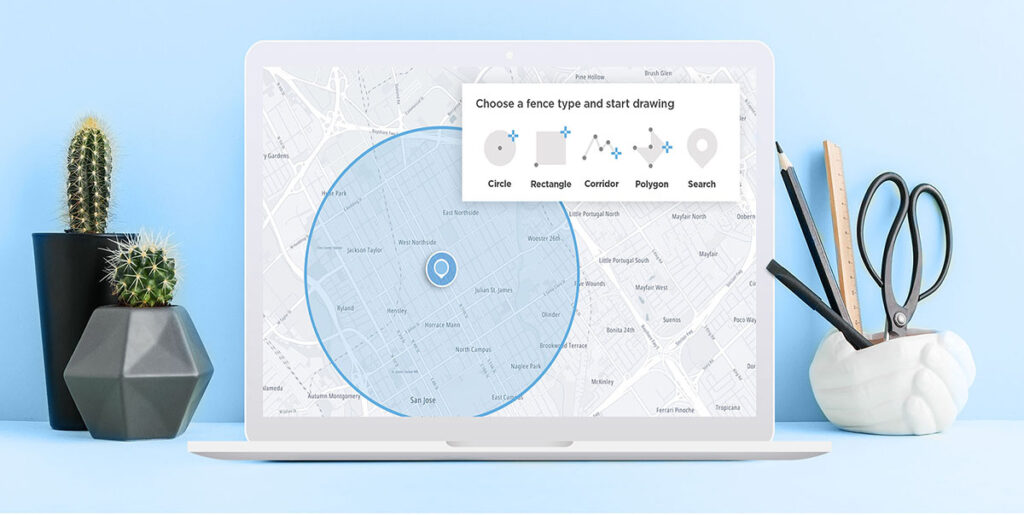Table of Contents
Modern business is now in a highly competitive environment, where there are already many ways to attract new customers and keep them engaged every day, it becomes more difficult. The use of geofences is a unique technology that enables a business to make relevant offers to various devices based on their geographic location in real-time. When we talk about “devices,” we mean everything from desktop computers to mobile phones and even smartwatches!
Previously, this technology was used in the basics of industrial sectors. Still, today the applications have become much broader, and we can see its application in many areas, such as social media, marketing, cybersecurity, and so on.
Using geofencing technology, you can send push notifications to users on mobile devices, serve targeted ads on social media, send text messages, and use location-based data in marketing.
According to research, 71% of adults in the United States use smartphones, and among teenagers, this percentage is even higher – 85%! Thanks to smartphones, geofence has become an ideal promotion tool and a component for creating local advertising.
If you want to improve your customer experience? Pay attention to this technology. Considering that 90% of decision-makers agree that good customer service is critical to their success.
If you are into any form of digital marketing, then this tool can help you attract new customers and turn them into repeat customers when used correctly. Maintaining brand loyalty and customer engagement is challenging, but geofencing helps you interact with customers in a personalized way that solves this problem.
Let’s take a look at what a geofence is and how it works and whether it suits your business and what needs to be considered when introducing this technology.
What is Geofencing?
Geofencing is a feature in mobile applications that use a global positioning system (GPS) or radio frequency identification (RFID) to mark geographic boundaries. Using this method, companies set triggers when a mobile device enters or leaves certain limitations. These triggers are usually in the form of push notifications.
There are three types of geofencing action triggers:
- static – based on the position relative to a particular place
- dynamic – user’s position relative to dynamic changes
- peer-to-peer – user’s position relative to other users
A fence created as a geographic boundary is called a geofence. This method is used to send offers to customers who pass, enter, or leave the geofence. Here are a few ways that owners can benefit from geofencing tactics in marketing:
- Increase traffic by sending your customer’s promotional offers.
- Suggest relevant products.
- Improve customer service by collecting their feedback.
- Increasing brand awareness.
How does geofence work?
Geofencing technology allows you to draw a virtual perimeter and delineate a real geographic location. The border of the geofence can be configured individually for the customer. That is, you can specify around what it should be created and fix the distance from your place of business or, for example, the place of business of your competitors.
Once this area is set up and secured, anyone who has your app and has permitted you to access their location can be tracked using the location services in this area dedicated to your geofencing campaign. In other words, every time a potential customer enters or leaves our range, they will receive an SMS, push notification, or any other message on their device.
Geofencing works with a combination of GPS, cellular, and Wi-Fi data.
Let’s talk about them in more detail.
GPS
GPS is one of the most popular technologies for determining a device outdoors because this technology is found in almost all mobile devices. GPS receives satellite signals, is highly accurate (up to 15 meters / 49 feet), works almost everywhere, and does not require an Internet connection. The disadvantage of this technology is that when the application uses GPS, the battery consumption increases significantly.
Cell ID
In case we cannot use the GPS signal to determine the location of the device, then we can use the cell towers located next to the phone. This method is not accurate enough, but the right way out for metropolitan areas.
Wi-Fi positioning
Wi-Fi positioning collects data from the Internet and demonstrates greater accuracy (up to 25-50 meters) due to the maximum Wi-Fi access range. It operates at high density in urban environments and drains the battery more slowly than GPS. But there is a downside – you should always have access to the nearest Wi-Fi point.
To start using geofencing technology, you need:
- make your mobile application (if it is not already there),
- select points of interest on the map,
- set the radius of geofences around them,
- configure application integration with the mailing service and transfer data.
After that, all mobile devices on which your application was downloaded will signal the mailing service when entering and leaving the specified zone.
Geofence boundaries can be active or passive. Active geofences require the end-user to enable location and open the mobile app. Passive geofences are always on. They use Wi-Fi and cellular data instead of GPS or RFID and run in the background.
What should be considered when implementing a geofence?
If you plan to use your application for building a geofence, then the following should be considered:
- The app should not rely solely on GPS, as GPS can dramatically reduce a mobile device’s battery life.
- The data you process can be used to improve the customer experience and for personalized targeting of users.
- Be sure to create a dashboard in your geofencing solution so that you can easily manage and optimize these zones.
- You should not spam your customers, so as not to cause negative.
What are the benefits of geofencing?
Difference Between Geofencing and Geolocation
Geolocation is tracking and is primarily related to a certain database of exact devices. Using geolocation, you track devices. Using geofencing, you track the location itself and “guard” the perimeters, identifying anybody who is “trespassing”. When you use geolocation, you know wherever a device is going. When you use geofencing, you know whoever is entering a predefined location.
Other Ways to Use Geofencing for Your Business
Many brands successfully use geofencing technology as a marketing tool and for the company’s internal needs, especially when it comes to security. Here are some examples of how you can use the geofence app:
- Asset Management: The app will notify the network administrator when a company asset intended for use within the firm goes down. And from there, they can track the location as well as block access to it.
- Fleet Management: This field uses a geofence to notify the dispatcher when a vehicle is approaching a loading/unloading area.
- Control of access zones – if an object cannot leave a particular zone or, conversely, be in it, geofencing signals a violation (the function became especially crucial during quarantine).
- Drone Control: Used to create a temporary restricted area for drones during a sporting event.
- Smart Home Tasks – When the owner approaches the home, the system is instructed to perform specific tasks, such as getting a bath.
How Burger King used geofencing
If you do not have many outlets yet and have not managed to build up your customer base, as Burger King’s experience shows, it is unnecessary to build geofencing around your dealership. Better to take a big competitor and create a geofence around it. It is this tactic, according to The New York Times, that turned more than 14,000 McDonald’s restaurants into Burger Kings.
Burger King marketers geo-targeted competitors’ restaurants so that a person had to get into a McDonald’s geofence to place an order for a Burger King burger for one cent. You could get your order at the nearest Burger King.
The aggressive marketing campaign was fueled by outdoor advertising: a call to download a mobile app for a virtually free burger motivated those fast food lovers who hadn’t yet done so.
The result is one and a half million downloads in 9 days.
The app rose from 686th place in downloads to the first, both in Google Play and in the AppStore. Even such monsters as YouTube, Facebook Messenger, and Instagram are left behind.
According to BK Internal Data, the ROI for Burger King’s geofencing campaign was 37:1.
Geofence Services
Getting the right marketing tools can help you get things done on time and more efficiently. Below are some of the best tools you can use:
# 1 LocationSmart
This tool gives marketers the ability to locate mobile users, engage, and establish interactions with users across devices. This approach helps to collect relevant data for analytics. This tool includes many marketing features, including geofencing, event triggers, and messaging. Location-based marketing can initiate and increase in-store purchases and motivate customers to take other actions locally.
#2 Koupon Media
It is a tool that offers buyers a targeted offer based on their location. They use a unique combination of geo-targeting and audience segmentation to deliver the best value possible. The mobile coupon network created by Koupon Media provides promotions, offers to mobile users while they are in the store. Retailers who register with Koupon Media to create geofences or specific virtual zones around their stores use geo-targeting to study shopper buying behavior and patterns, and then send out personalized offers based on audience preferences. Also, retailers can install beacons so you can deliver real-time offers while consumers shop in the store.
How much does it Cost to Develop a Custom Geofencing Solution?
Most of the existing apps provide a limited set of functions. In the existing apps, you may find limited features and, most importantly, no customization options. Because of these reasons our clients asked us to develop a proprietary geofencing solution.
| Dev stages | Dev hours |
| Business Analyst | 130-170 |
| Designer | 70-120 |
| DevOps | 28-32 |
| Backend | 400-600 |
| Frontend | 180-220 |
| HTML/CSS | 50-70 |
| Android | 240-280 |
| iOS | 240-280 |
| QA | 310-522 |
If you decide to work with a coding team from Ukraine, the custom development of a web portal will cost you on average $43,000-55,000. Of course, there is no top threshold and the final price may be much higher, for example, in case you want to build a very complex solution with many features.
To conclude
Geofencing technology began to be used not so long ago, but today, when a client’s struggle is getting more challenging, it is being used more actively. In the article, we talked in great detail about the technology, how it works, and its benefits to your business. Using this example, we have clearly shown how you can significantly expand your client base and increase income utilizing this technology. Have you tried using Geofencing to broaden your customer base and industry share? Let’s start from the very beginning by creating an application so that you can make the best use of Geofence.
FAQ
- Describe the portrait of the client, define the points around which you want to create a geofence and more. Make sure the geofence is in line with your existing marketing strategy.
- Select the appropriate geofencing software to be implemented in your application.
- Implement this in your application.
- Test your application.
- Create your push notification ad campaigns.
#2 Independence. Geofencing is effective when customer data from other sources is synchronized with data obtained from this technology. Thus, geofencing is not a stand-alone technology for producing quality business intelligence.
#3 Battery life. The use of GPS in your phone dramatically affects the battery life of the device. Therefore, many users turn off this technology on the phone, which means that you will not send a message to your potential client at the appropriate time.










